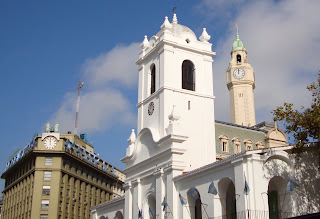
Built in 1936, the Kavanagh building was financed by Corina Kavanagh, one of Argentina’s wealthiest women at the time, who invested all she had inherited and sold all her other properties to build this, her very own skyscraper. Designed to be as slender as possible in order to avoid unnecessary weight, the building is considered to be the apex of early Modernism in Argentina.
At the time it was highest reinforced concrete structure in the world and the tallest building in South America for many years. Those on the upper floors have exquisite terrace gardens with views of the river, parks and the city. Corina Kavanagh lived for many years on the 14th floor in the largest apartment, the only one that occupies an entire floor.
As the story goes, the shape of the building was also designed as a revenge. One of Corina's daughters, who was wealthy but not aristocratic, fell in love with the son of the Anchorena family, who were both wealthy, aristocratic and lived in a palace. They disapproved of the engagement and had built a church next to the site of the Kavanagh Building. In revenge, Corina decided to build a skyscraper that would block the view of the church from their palace.












.JPG)




































